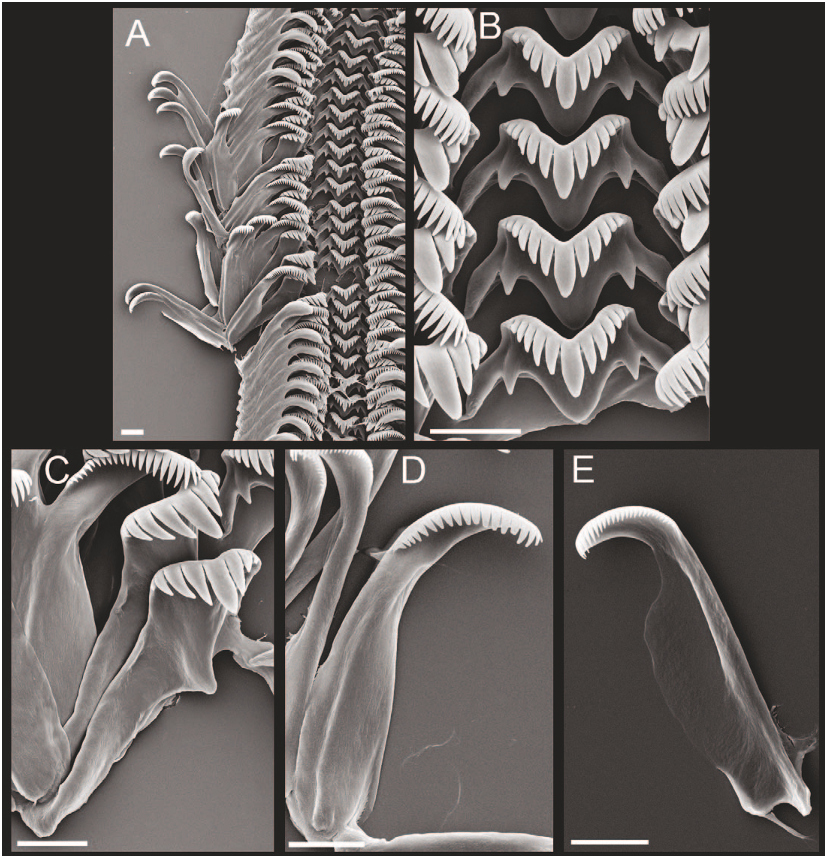investigations of Pyrgulopsis (Hershler 1998,
Hershler et al. 2003a). Basic statistics were com-
piled for the shell data using Systat for Windows
11.00.01 (SSI 2004).
Genomic DNA was extracted from entire
snails using a CTAB protocol (Bucklin 1992). A
658 bp segment of cytochrome c oxidase sub-
unit I (COI) corresponding to “Folmer’s frag-
ment” (Folmer et al. 1994) was amplified and se -
quenced with primers LCO1490 and HCOI2198
following protocols of Liu et al. (2003). Se -
quences were determined for both strands and
then edited and aligned using Sequencherä
version 4.8. We sequenced 3–6 specimens from
the 2 samples of the new species described
herein to assess variation. Sample information
and GenBank accession numbers for the se -
quenced specimens utilized in this study are in
Table 1. The new sequences reported herein
were deposited in GenBank under accession
numbers JN255350–JN255358 (Table 1).
Sequence divergences (uncorrected p dis-
tances) were calculated using MEGA5.05 (Ta -
mura et al. 2011). Preliminary molecular phy-
logenetic analyses, which included most of the
currently recognized species of Pyrgulopsis,
consistently positioned the novelty described
herein in a clade with 9 other congeners. The
final analysis included all of these taxa and 2
congeners that belong to a different clade from
the northern Lahontan basin; one of these con -
geners (Pyrgulopsis gibba) was used as the root.
Phylogenetic relationships were inferred using
Bayesian inference in MrBayes 3.12 (Ronquist
and Huel senbeck 2003). MrModeltest (Nylan-
der 2004) selected the general time reversible
model (GTR + G), which best fit the data under
the Akaike information criterion. In the initial
Baye sian analysis, the burn-in was set at 10%
(10,000 generations) of the chain length (100,000
generations). Three runs were conducted in
MrBayes using the General Time Reversible
model (GTR + G) selected by MrModeltest and
the default random tree option to determine
when the log-likelihood sum reached a stable
value (by plotting the log-likelihood scores of
sample points against generation time). The ln
likelihoods started around –7550 and quickly
converged upon a stable value of about –1700
after 8000 generations. For the final run, Me -
tropolis-coupled Markov chain Monte Carlo
simulations were performed with 4 chains for
1,000,000 generations, and Markov chains were
sampled at intervals of 10 generations to obtain
100,000 sample points. The sampled trees with
branch lengths were used to generate a 50%
majority-rule consensus tree with the first 5000
trees (equal to 50,000 generations) removed to en -
sure that the chain sampled a stationary portion.
S
YSTEMATIC DESCRIPTION
Family Hydrobiidae Troschel, 1857
Subfamily Nymphophilinae Taylor, 1966
Genus Pyrgulopsis Call and Pilsbry, 1886
Type species: Pyrgula nevadensis Stearns, 1883, by origi -
nal designation.
Diagnosis: Liu and Hershler (2005:296).
Pyrgulopsis cybele, new species
T
YPES.—Holotype, USNM 1148155, un -
named spring brook on east side of South Fork
Owyhee River, Elko County, Nevada, N
4648124, E 524954, Zone 11, 1439 m elevation,
coll. RH and Chris Hansen, 1 November 2010.
Paratypes (from same lot), USNM 1157696
(ca. 400 specimens).
E
TYMOLOGY.—This species is named after
Cybele, the Roman goddess of nature.
Referred material: NEVADA. Elko County:
USNM 1128557 (ca. 150 specimens), unnamed
spring brook on east side of South Fork Owyhee
River, ca. 100 m north of the above, N 4645315,
E 525593, Zone 11, 1463 m elevation, coll. RH,
2 June 2009.
D
IAGNOSIS.—A small species of Pyrgulopsis
having a trochoid to ovate-conic shell with
highly convex whorls and a thickened inner
apertural lip. Penis having a medium-sized lobe
and medium-length filament; ornament consist-
ing of penial gland, Dg1, and terminal gland.
D
ESCRIPTION.—Shell trochoid to ovate-conic
(Fig. 2A–D); height 1.6–2.8 mm; whorls 3.25–
4.00. Periostracum tan. Protoconch near plani -
spiral, about 1.4 whorls, diameter about 420 μm,
initial portion weakly wrinkled (Fig. 2E, 2F).
Teleoconch whorls highly convex, shouldered,
sutures impressed, last whorl sometimes slightly
loosened behind aperture; smooth apart from
collabral growth lines. Aperture large, ovate,
angled above. Inner lip complete, usually slightly
disjunct, rarely adnate, thickened internally,
sometimes markedly so; columellar shelf usually
absent, narrow to moderate width when present;
outer lip usually thin, sometimes thickened
adapically, prosocline. Umbilicus usually small,
narrow, rarely absent. Shell measurements and
2012] NEW SPRINGSNAIL FROM NEVADA 23

















